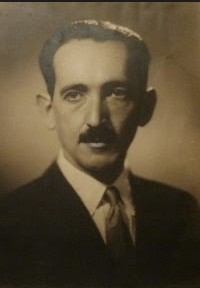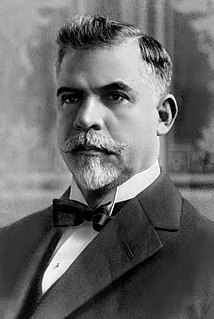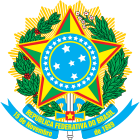
Plínio Salgado was a Brazilian politician, writer, journalist, and theologian. He founded and led Brazilian Integralist Action, a political party inspired by the Fascist regimes of Benito Mussolini and Adolf Hitler.

Luís Carlos Prestes was a lieutenant, later communist militant and Brazilian politician. He was one of the organizers of the 1920s tenente revolts and the communist opposition to the Vargas Era in Brazil. He was also the general-secretary of the Brazilian Communist Party.

The Vargas Era is the period in the history of Brazil between 1930 and 1945, when the country was under the dictatorship of Getúlio Vargas.

Tenentism was a political philosophy of junior army officers who contributed significantly to the Brazilian Revolution of 1930.

Washington Luís Pereira de Sousa was a Brazilian politician who served as the 13th President of Brazil, the last of the First Brazilian Republic.

Olga Benário Prestes was a German Brazilian communist militant gassed by Nazi Germany.

The Constitutionalist Revolution of 1932 is the name given to the uprising of the population of the Brazilian state of São Paulo against the 1930 coup d'état when Getúlio Vargas forcibly assumed the nation's Presidency; Vargas was supported by the military and the political elites of Minas Gerais, Rio Grande do Sul and Paraíba. The movement grew out of local resentment from the fact that Vargas ruled by decree, unbound by a Constitution, in a provisional government. The 1930 coup also affected São Paulo by eroding the autonomy that states enjoyed during the term of the 1891 Constitution and preventing the inauguration of the governor of São Paulo Júlio Prestes in the Presidency of the Republic, while simultaneously overthrowing President Washington Luís, who was governor of São Paulo from 1920 to 1924. These events marked the end of the First Republic. Vargas appointed a northeasterner as governor of São Paulo.

João Pessoa Cavalcanti de Albuquerque was the governor of Paraíba between 1928 and 1930.

General elections were held in Brazil on 2 December 1945, the first since the establishment of Getúlio Vargas' Estado Novo. The presidential elections were won by Eurico Gaspar Dutra of the Social Democratic Party (PSD), whilst the PSD also won a majority of seats in both the Chamber of Deputies and the Senate. Voter turnout was 83.1% in the presidential election, 83.5% in the Chamber elections and 76.7% in the Senate elections.

Getúlio Dornelles Vargas was a Brazilian lawyer and politician, who served as President during two periods: the first was from 1930–1945, when he served as interim president from 1930–1934, constitutional president from 1934–1937, and dictator from 1937–1945. After being overthrown in a 1945 coup, Vargas returned to power as the democratically elected president in 1951, serving until his suicide in 1954. Vargas led Brazil for 18 years, the longest of any President, and second in Brazilian history only to Emperor Pedro II among heads of state. He favored nationalism, industrialization, centralization, social welfare and populism – for the latter, Vargas won the nickname "The Father of the Poor". Vargas is one of a number of populists who arose during the 1930s in Latin America, including Lazaro Cardenas and Juan Perón, who promoted nationalism and pursued social reform. He was a proponent of workers' rights as well as a staunch anti-communist.

Presidential elections were held in Brazil on 3 October 1955. The result was a victory for Juscelino Kubitschek, who received 35.7% of the vote. Voter turnout was 59.7%.
The history of the socialist movement in Brazil is generally thought to trace back to the first half of the 19th century. There are documents evidencing the diffusion of socialist ideas since then, but these were, however, individual initiatives with no ability to form groups with actual political activism.

The Coluna Prestes, also known as the Prestes Column, was a social rebel movement between 1925 and 1927 in Brazil, with links to Tenente revolts. The ideology of the movement was diffuse, but the main issues were dissatisfaction with the República Velha, the institution of the secret ballot, and the defense of public education. A 25,000 km march through the Brazilian countryside, the march did not aim to defeat the enemy forces of the Federal government, but rather to ensure the insurrectionists' survival and their ability to continue threatening the federal government.
Francisco Prestes Maia (1896–1965) was a Brazilian architect, civil engineer, urban planner, and professor, who served three terms as mayor of the city of São Paulo.

Events in the year 1930 in Brazil.

Events in the year 1935 in Brazil.

Estação Júlio Prestes is a historic railroad station building in São Paulo, Brazil. In addition to commuter rail service, Júlio Prestes Station is also a cultural arts center, Centro Cultural Júlio Prestes, with a performance space, Sala São Paulo, and administrative offices for state-run arts programs.


















